|
 570 3rd Ave # 219 570 3rd Ave # 219
Bethel, AK 99559
(907) 543-1541
 625 C Street
Anchorage, AK 99501 625 C Street
Anchorage, AK 99501
(907)929-9200
anchoragemuseum.org
|
|
 |
A raised paddle held in the ten o'clock position indicated that the paddler had sighted a seal on the ice. A man who raised his paddle and waved it back and forth was calling for help. When the route ahead was blocked or dangerous, a man would raise his paddle and let it fall toward the direction where it was safe to travel. Frank explained: "If he sees that, even though he's far away, he would turn before he got to the dangerous spot." Noah Andrew (pictured above) noted that at the mouth of the Kuskokwim, hunters today use these same signals.
|
Negcik Gaff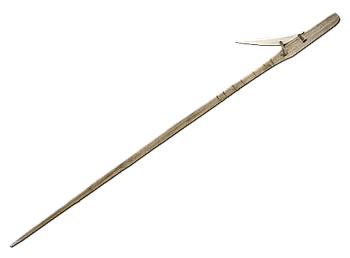 |
Description
Gaff referred to by Frank Andrew as a "life hook." John Phillip said, "Down on the ocean, the negcik was our most important tool."
The gaff was used to test the strength and thickness of ice, to keep a hunter from falling through cracks, to steady the kayak when entering and exiting, and to pull a man to safety in an emergency.
Dimensions
L- 72 1/4 in
W- 8 1/4 in
Diameter- 1 1/2 in
Credits
E. W. Nelson, 1896, Nunivak,Department of Anthropology, Smithsonian Institution 175668
|
Negcikcuar Small Gaff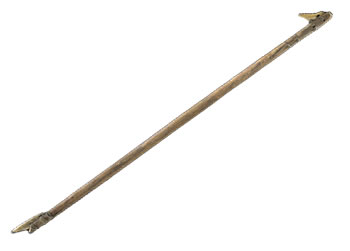 |
Description
Alex Bird said, "When they hunted geese, they pushed their catches inside their kayaks. When they unloaded, they used the small gaff to get their catches out.
Dimensions
L- 47 in
W- 3 in
H- 1 in
Credits
E. W. Nelson, 1879, Anuurarmiut, Department of Anthropology, Smithsonian Institution 36022
|
Nuqaq Spear Thrower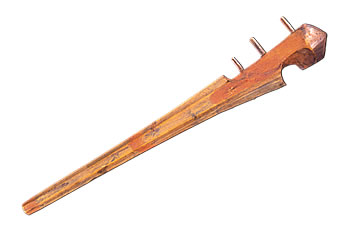 |
Description
Spear thrower used by both men and women. Annie Blue said, "This device made the spear go farther, and it will make the throw more powerful."
Dimensions
L- 18 1/2 in
W- 3 1/4 in
D- 1/2 in
Credits
C. L. Hall, 1904, Peabody Museum of Archaeology and Ethnology, Harvard University 63547
|
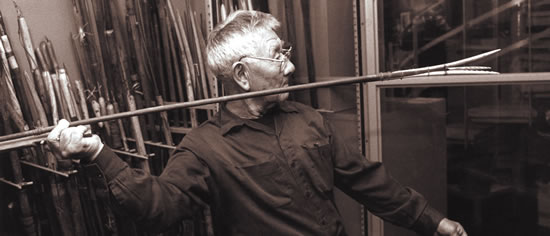 |
Photo: Ann Fienup-Riordan |
Paul John demonstrates the use of a spear thrower.
Frank Andrew recalled: "At high tide, they let us practice throwing seal-hunting spears using a spear thrower. We aimed at little things, pretending that the foam was a floating seal."
|
Aklegaq Barbed Harpoon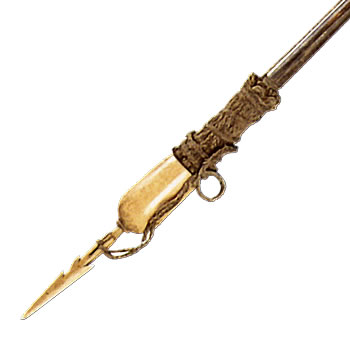 |
Description
Barbed harpoon with seal bladder float. Peter John called the barbed point the "harpoon's hand" that held onto the animal that was pierced.
Dimensions
L- 50 1/2 in
Diameter- 1 3/4 in
Credits
J. A. Jacobsen, 1882,
Ethnologisches Museum Berlin IVA5230
|
Nagiiquyaq Seal Hunting Spear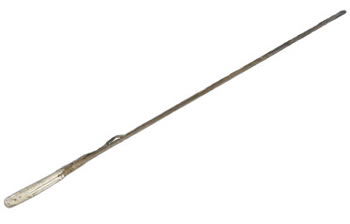 |
Description
The heavy socket piece, made to hold a barbed point, weights the front and allows the spear to float upright in water for easy retrieval.
Dimensions
L- 54 1/2 in
W- 1 1/4 in
H- 1 1/2 in
Credits
E. W. Nelson, 1879, lower Kuskokwim River, Department of Anthropology, Smithsonian Institution 36081
|
Asaaquq Toggling Harpoon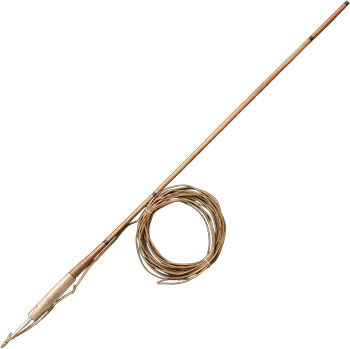 |
Description
Dennis Sheldon noted: "The harpoon point gets left behind in the animal and turns sideways. When the hole where the point entered is small, and when it suddenly turns sideways, it cannot come off."
Dimensions
L- 60 3/4 in
W- 12 in
Diameter- 2 in
Credits
Phoebe Apperson Hearst Museum of Anthropology,
University of California, Berkeley 2-1809
|
Aangruyak Dispatching Weapon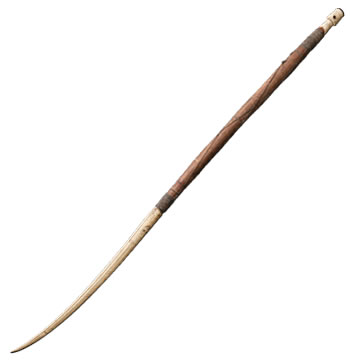 |
Description
Frank Andrew said: "To hunt walrus, you would insert the point into the shaft. When it hits the walrus, because it is heavy and has a strong impact, it forces the point deep inside. The shaft would then fly back."
Dimensions
L- 58 3/4 in
W- 2 1/2 in
Diameter- 1 3/4 in
Credits
Nunivak, Phoebe Apperson Hearst Museum of Anthropology, Berkeley, California 26286
|
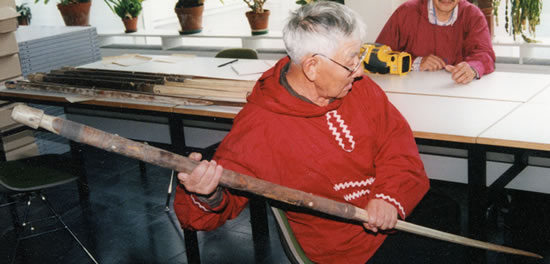 |
Photo: Ann Fienup-Riordan |
Paul John demonstrates one use of the Nunivak lance at the Ethnologisches Museum Berlin, 1997.
|
Qalagyaq Walrus Harpoon Point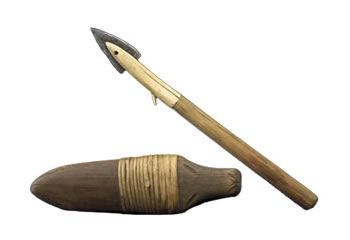 |
Description
Frank Andrew noted: "This is the covering, bound together with spruce roots. This also has a small point at the spearhead's edge, that would pierce when it hits."
Dimensions
Cover
L- 8 in
W- 2 1/2 in
D- 1 1/4 in
Credits
W. H. Dall, 1874, Nunivak, Department of Anthropology, Smithsonian Institution 16350
|
Qalugyaq Walrus Harpoon Point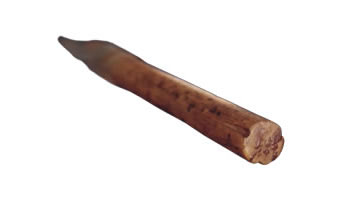 |
Description
Frank Andrew explained the incisions on the point's base: "Some have these small spaces that provide an air pocket in the insertion hole, where the point is attached. These spaces aren't decorations but are filled with [compressed] air that can help the shaft come off easily and fly back."
Dimensions
L- 5 1/2 in
W- 1 1/2 in
H- 1 1/4 in
Credits
E. W. Nelson, 1879, Cape Vancouver, Department of Anthropology, Smithsonian Institution 37389
|
Next
|
|

